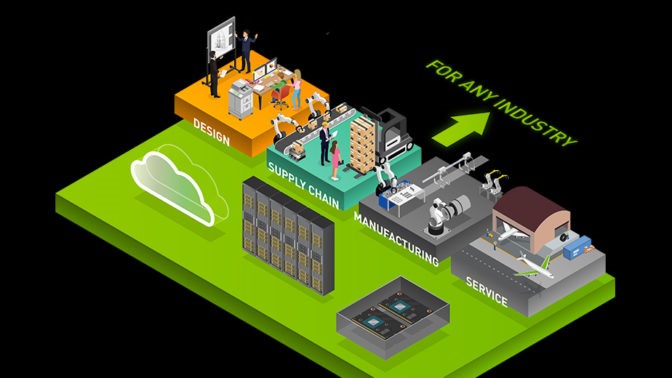Nvidia edge computing is transforming data processing, allowing for instantaneous analysis and decreased response times in a variety of industries. Its implementation in smart cities and autonomous vehicles improves efficiency and user satisfaction. This technology is reshaping the tech industry and has a growing influence on both businesses and consumers, fostering innovation and more advanced solutions.
What is Edge Computing, and How Does It Work?
Edge computing is a decentralized approach to data processing that brings computation and storage closer to the source of data generation. Instead of relying solely on distant cloud servers, edge devices analyze and process information locally.
How It Works
- Data Collection: Sensors, cameras, and IoT devices gather extensive data.
- Local Processing: Instead of sending all data to the cloud, edge devices process critical information on-site.
- Faster Decision-Making: With reduced network dependency, real-time responses are possible, minimizing latency.
- Optimized Bandwidth Usage: Only essential data is sent to central servers, reducing network congestion.
Edge computing is revolutionizing industries by enabling real-time, intelligent, and efficient operations. From smart cities to healthcare and industrial automation, it is reshaping how technology enhances daily life and business processes.
The Advantages of NVIDIA Edge Computing
NVIDIA Edge Computing offers a range of advantages that set it apart in the tech landscape. By processing data closer to the source, it enhances efficiency, security, and responsiveness across various applications.
1. Faster Processing Speeds
NVIDIA edge computing accelerates processing by bringing data computation closer to the source, reducing travel time, and enabling lightning-fast responses. Its powerful GPUs handle complex tasks like real-time analytics and machine learning with ease, making it ideal for applications where speed is critical—such as autonomous vehicles, facial recognition, and augmented reality. Faster processing leads to quicker decision-making, transforming user experiences across industries.
2. Lower Latency
NVIDIA edge computing significantly reduces latency by minimizing data transmission delays and enhancing system responsiveness. This is crucial for time-sensitive applications like autonomous driving, gaming, and real-time analytics, where every millisecond matters. Lower latency not only improves safety and efficiency but also optimizes device communication, pushing the boundaries of innovation beyond traditional cloud solutions.
3. Improved Energy Efficiency
NVIDIA edge computing reduces energy consumption by processing data closer to the source, minimizing long-distance transmissions and cloud dependency. Its GPUs optimize workloads efficiently, delivering high performance with lower power usage. Additionally, intelligent low-power states during idle periods further enhance energy savings. Businesses adopting NVIDIA edge solutions improve efficiency while contributing to sustainability.
4. Enhanced Security
By keeping data local, NVIDIA edge computing reduces exposure to cyber threats and minimizes vulnerabilities from network transmissions. AI-driven real-time anomaly detection enables rapid threat response, while advanced encryption secures data in storage and transit. As businesses rely more on IoT and interconnected devices, NVIDIA’s security-first approach strengthens cybersecurity in the digital age.
5. Scalability and Flexibility
NVIDIA edge computing allows seamless scalability without infrastructure overhauls. Its modular design supports dynamic resource allocation and quick integration with various devices and applications. Businesses can experiment with different configurations, optimizing performance and fostering continuous innovation in a competitive landscape.
Real World Applications of NVIDIA Edge Computing
NVIDIA edge computing is revolutionizing industries by enabling real-time data processing, enhancing efficiency, and optimizing decision-making. From autonomous vehicles to smart cities, healthcare, and industrial IoT, its impact is profound.
1. Autonomous Vehicles
NVIDIA edge computing is revolutionizing autonomous vehicles by enabling real-time data processing from sensors and cameras. This allows for split-second decision-making, improving safety and efficiency in complex environments.
AI-driven learning enhances vehicle performance over time, while ultra-low latency ensures rapid responses to obstacles. Additionally, vehicle-to-everything (V2X) communication enhances traffic management and accident prevention. As self-driving technology advances, NVIDIA’s edge solutions remain pivotal in shaping the future of mobility.
2. Smart Cities
Smart cities leverage NVIDIA edge computing to optimize urban living through real-time data processing. Traffic flow is dynamically managed, reducing congestion and emissions. Public safety improves with AI-powered surveillance, detecting anomalies for proactive responses.
Smart grids enhance energy efficiency, and IoT-enabled waste management ensures timely pickups while cutting costs. As these technologies evolve, NVIDIA continues to drive innovation, making cities more sustainable and efficient.
3. Healthcare Industry
NVIDIA edge computing is revolutionizing healthcare by enabling real-time data analysis at the source. Wearable devices can instantly process vital signs, alerting doctors to anomalies without delay. Telemedicine benefits from seamless high-definition video consultations, improving remote diagnostics and treatment.
Additionally, edge computing enhances data security by keeping sensitive health information within local networks, reducing exposure risks. AI-driven analytics further improve diagnostic accuracy and enable personalized treatment plans.
4. Industrial IoT (IIoT)
IIoT is reshaping industries by connecting machines, sensors, and devices for real-time data analysis. NVIDIA edge computing enhances this transformation by processing data locally, reducing reliance on centralized servers, and accelerating response times. Manufacturers can implement predictive maintenance, minimizing downtime and optimizing equipment performance.
Sectors like energy and logistics achieve efficiency gains, leading to cost savings and sustainability improvements. NVIDIA’s edge computing solutions continue to drive advancements in industrial automation and smart operations.
Impact on the Tech Industry
NVIDIA edge computing is disrupting traditional data centers by shifting processing closer to the data source, enabling faster decision-making and real-time analytics. Businesses are adapting their infrastructure investments to align with this transition.
Industry leaders like Microsoft and Google are collaborating with NVIDIA to integrate cutting-edge AI capabilities into their cloud services, fueling innovation across sectors. However, integrating edge solutions into existing systems presents challenges, requiring careful planning and investment.
Disrupting Traditional Data Centers
NVIDIA edge computing is revolutionizing traditional data centers by decentralizing data processing. By handling computations closer to the source, businesses can reduce congestion, enhance speed, and eliminate dependence on centralized servers.
Powerful edge GPUs enable real-time data analysis, improving responsiveness to dynamic demands. As edge devices grow more intelligent, they assume tasks once exclusive to large-scale servers, leading to cost savings and sustained high performance.
Additionally, edge computing supports dynamic resource allocation, optimizing efficiency while minimizing waste. This transformation is reshaping infrastructure strategies making operations more agile and scalable.
Collaboration with Other Tech Giants (Microsoft, Google, etc.)
NVIDIA’s innovations in edge computing have attracted major tech players like Microsoft and Google, leading to strategic collaborations that redefine data processing at the edge.
Through these partnerships, NVIDIA enhances cloud services with cutting-edge AI capabilities, enabling businesses to extract real-time insights directly from their devices without relying heavily on centralized servers.
- Microsoft Azure integrates NVIDIA’s GPUs to optimize performance for machine learning, AI inference, and high-performance computing, significantly improving workload efficiency.
- Google Cloud leverages NVIDIA’s technology to enhance its Kubernetes offerings, allowing businesses to manage workloads more effectively while benefiting from low-latency processing.
These alliances not only drive advancements in AI-driven cloud solutions but also position companies at the forefront of edge computing innovation. By working together, NVIDIA and its partners create a powerful ecosystem that meets modern business demands and unlocks future growth opportunities across industries.
Challenges and Concerns Surrounding NVIDIA Edge Computing
NVIDIA edge computing offers transformative benefits, it also presents several challenges that organizations must address:
- Complex Deployment – Integrating edge computing into existing IT infrastructure can be daunting, requiring significant planning and technical expertise.
- Security Risks – Decentralized systems introduce new vulnerabilities, increasing the risk of cyber threats. Businesses must implement robust security measures to protect sensitive data.
- Legacy System Compatibility – Many enterprises still operate on outdated technology, making seamless integration with NVIDIA’s advanced solutions a challenge.
- Cost Considerations – While edge computing can lead to long-term cost savings, the high initial investment in hardware, software, and infrastructure upgrades may be a barrier for smaller companies.
- Skills Gap – Managing and optimizing edge computing solutions requires specialized knowledge. The shortage of skilled professionals in AI and edge computing poses a significant adoption hurdle.
Despite these challenges, companies that strategically navigate these obstacles can unlock significant advantages in speed, efficiency, and innovation.





